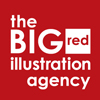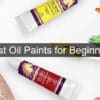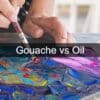How to Color With Markers Without Streaks – a Quick Guide

Alcohol-based markers, water-based markers, and oil-based markers can all be great for art projects. However, many people struggle to avoid streaks with their marker strokes.
If this is something you struggle with, you’ll want to continue reading the tips below. They walk you through how to color with markers without streaks, regardless of whether you’re using brush markers or alcohol markers.
Marker Paper
The best paper to use for using markers without streaks is Bristol board paper. This marker paper will absorb ink for a smooth ink-dry process. It includes multi-ply sheets that are excellent for helping you to color evenly. It’s one of the types of paper used by most professional artists due to how the paper fibers are thick.
Uncoated papers tend to cause dark streaks and can be difficult to use to how they absorb ink too quickly. Thick papers, such as matte paper, are better than thin papers for streak-free art.
Circular Strokes
Implementing a circular motion whilst using quality markers will help you to avoid streaks. Ensure that you use quality paper and start with small circles, gradually making big circles.
You can use this method to practice your shading by adding darker and lighter shades of the same color. The circular pen strokes can help you improve shading without leaving streaks.
Consistent Coloring
Practising your ability to color continuously is vital for learning to color evenly and without streaks. Keep the marker on your ideal paper until the entire area has been filled. You can practice this with a coloring book by not lifting the pen from the page until the section is completely colored.
Coloring quickly with a tight weave will also help to prevent streaks.
Flicking Technique
When it comes to the flicking pattern technique, find an area that you want to be a shade darker than the rest. Then, create lighter shade strokes for the area that you want to contract with the dark shades.
Blend the two together by using the fine end of a marker, a slightly lighter shade than the darker colors so that they overlap.
Continue using the flicking pattern with your marker nibs and changing the shade as you see fit until the shades begin to blend. This technique prevents streaks and adds another dimension to your work.
Fluent Marker Strokes
Using smooth, fluent strokes is great for preventing your marker tip from drying. If the ink dries, you won’t be able to achieve the same result.
Instead, avoid letting the ink dry and smoothly continue to color in the area with several layers. Adding a second layer quickly after the first one prevents uneven coverage.
Conclusion
That concludes our post on how to prevent ink streaks when coloring with markers. Be sure to implement the tips mentioned above and practice them over and over. The better you get, the more confident you’ll be when bringing your dark colors and lighter shades together.
FAQs
What are the best markers for coloring?
Copic Markers are considered to be fantastic for shading lighter areas and darker areas with accuracy. Other markers that you may want to consider include Sharpies and Crayola.
Affiliate Disclosure
In compliance with the FTC guidelines, please assume the following about all links, posts, photos and other material on this website: Any/all of the links on this website are affiliate links of which The Big Red Illustration Agency receives a small commission from sales of certain items, but the price is the same for you. www.bigredillustrationagency.com is a participant in the Amazon Services LLC Associates Program, an affiliate advertising program designed to provide a means for sites to earn advertising fees by advertising and linking to Amazon.com & Amazon.co.uk. Pages on this site may include links to Amazon and its affiliate sites on which the owner of this website will make a referral commission.
FULL TERMS HERE Cookie preferences: cookie preferences

Written By Adam Rushton
Adam has made a name for himself in the illustration industry and is a passionate blogger and writer on the subject of art, illustration and graphic design.
His artwork has been featured in countless publications and used for very well-known media projects. As a professional illustrator for over 20 years, Adams media outlets, a wealth of knowledge, and experience enable him to consult and advise artists and illustrators in this country (from York and Manchester to Southampton and London) and all over the world.



































